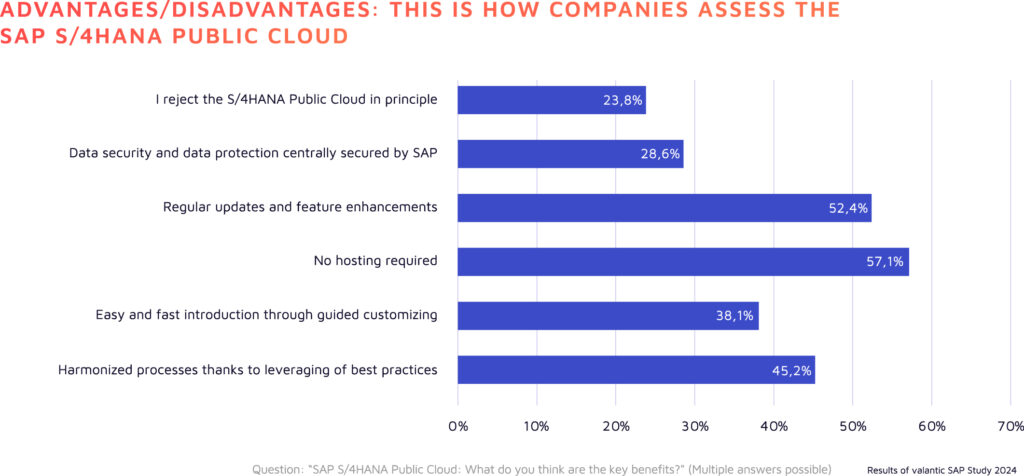Highlight

Successful together – our valantic Team.
Meet the people who bring passion and accountability to driving success at valantic.
Get to know usSeptember 4, 2024

Since 2018, valantic has been surveying top-tier SAP experts annually to gauge their perspectives on S/4HANA migration, investment trends, preferred technologies, and emerging business opportunities. In 2024, the survey was extended to include questions on artificial intelligence and companies’ AI strategies. By comparing year-on-year results, the survey reveals long-term trends and evolving developments.
Background: The 2024 online survey was conducted in two waves during the first half of the year, with 200 SAP experts and IT managers from the DACH region participating.
Unsurprisingly, companies are currently intent on evaluating how artificial intelligence (AI) can be seamlessly integrated into SAP modules and corporate workflows to maximize value and engender significant benefits. One of the key findings from the survey is the enormous confidence placed in SAP’s platform of the future, S/4HANA, with 78.6% of participants—by far the largest share—planning to migrate to the platform; in doing so, their goal is to harness AI, predictive analytics, and associated data science technologies to leverage automation to improve their competitiveness and business success.

Survey participants see even more business advantages with the migration to S/4HANA: the platform simplifies the standardization of SAP applications and expedites transforming business workflows into real-time processes. These are significant benefits and compelling motivators. As a result, 23.8% have already completed their transition to S/4HANA, while 21.4% (up from 9.5% the previous year) are currently in the midst of their migration. The biggest leap, however, is seen in the planning stage—45.2% are now actively contemplating and preparing for a switch to S/4HANA, more than triple the 13.2% recorded in 2023.
The valantic SAP Study 2024 delivers a clear conclusion: SAP S/4HANA is firmly established in companies— it is no longer a question of “if” but rather “how and when” the migration will proceed. For companies with older systems (accounting for over a quarter of respondents), the greenfield approach is attractive, using the migration as an opportunity for a comprehensive overhaul of their processes and systems. This contrasts with companies with newer SAP installations which lean towards the faster, more cost-efficient brownfield approach (40.5%).
Digitalization and SAP consulting firms like valantic offer a third option: the Extended Brownfield/Bluefield approach, which skillfully blends the flexibility of greenfield with the speed and cost-effectiveness of brownfield. Combining the best of both migration worlds, this intelligent hybrid approach resonates with 33.3% of participants, who indicated they would opt for valantic’s refined strategy for their SAP S/4HANA migration.

The responses to where companies prefer to host their S/4HANA systems are also revealing. Despite the widespread hype surrounding the cloud—now considered standard for many services—nearly 60 percent of the companies surveyed by valantic still prefer on-premises operations for their most critical asset: their ERP system. This is surprising and possibly due to a lack of communication and education about cloud solutions. Nevertheless, 31 percent of respondents are transitioning to the secure SAP S/4HANA Private Cloud, tailored specifically to their company’s needs. However, only 9.5% feel confident using the SAP S/4HANA Public Cloud. Our blog article offers guidance on which of the options—Private or Public Cloud—to choose.

Guidelines for selection and arguments for switching
With SAP S/4HANA Public Cloud and Private Cloud, many companies have the option of using high-performance ERP as a SaaS for the future.

The survey also revealed that SAP users fully recognize the strategic importance of AI in the corporate environment and are eager to unlock its numerous benefits. Alongside SAP S/4HANA, artificial intelligence has emerged as the other megatrend for SAP this year. SAP made an important move last September with the prominent launch of its AI assistant, Joule. According to SAP, because Joule is designed to understand business contexts and is seamlessly integrated into companies’ mission-critical business processes, it greatly benefits SAP cloud applications like HR management, finance, supply chain management, and BTP. Some companies have already seen impressive results, achieving up to 90% faster root cause analysis and saving thousands of production hours using a GenAI Supply Chain Troubleshooter—the same generative AI technology powering Joule.

Given these results, it is no surprise that the AI assistant Joule is the most popular AI application, favored by 42.9% of users. Additionally, SAP user companies recognize significant potential in leveraging SAP Build Code alongside Joule to achieve substantial benefits, such as enhanced efficiency and productivity.

The SAP Business Technology Platform (BTP) lets companies integrate AI and custom developments into their SAP application ecosystem, even in the cloud, quickly and with minimal effort. While BTP is primarily for SAP experts, it is crucial for unlocking the full potential of AI. According to the valantic SAP Study 2024, significant strides have been made in this area. Currently, 56% of survey participants (SAP user companies) are utilizing BTP, a sharp increase from 34% the previous year, with a further, almost 21% planning its introduction soon.
This data clearly shows how SAP’s longstanding initiative is gaining traction, and most SAP user companies are now beginning to capitalize on the extensive benefits BTP offers.
Despite the promises of artificial intelligence and the SAP Business Technology Platform (BTP), this year’s valantic survey reveals an ongoing challenging relationship between the two. Seamless integration remains elusive even though BTP is ideally suited for smoothly incorporating AI solutions into the SAP ecosystem. Only 5.5% of participants have explored BTP’s AI capabilities in detail to date, while 36.7% have investigated them superficially. The remaining 57.8% have yet to engage with these features.
This unfortunate shortfall limits the potential benefits that SAP user companies could gain from integrating BTP and AI. SAP experts from management consultancies like valantic can play a crucial role in bridging this gap, helping companies unlock and maximize the value of BTP and AI.

valantic SAP Study 2024
Access the study report directly to gain valuable insights into the latest trends and developments in digitalization with SAP.
Don't miss a thing.
Subscribe to our latest blog articles.